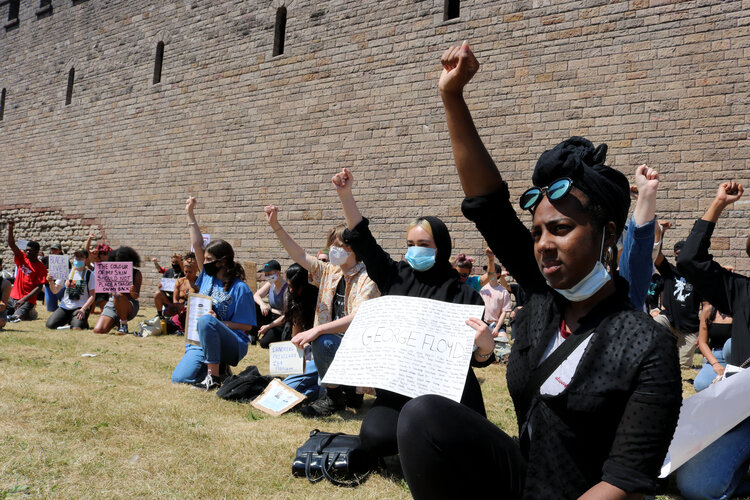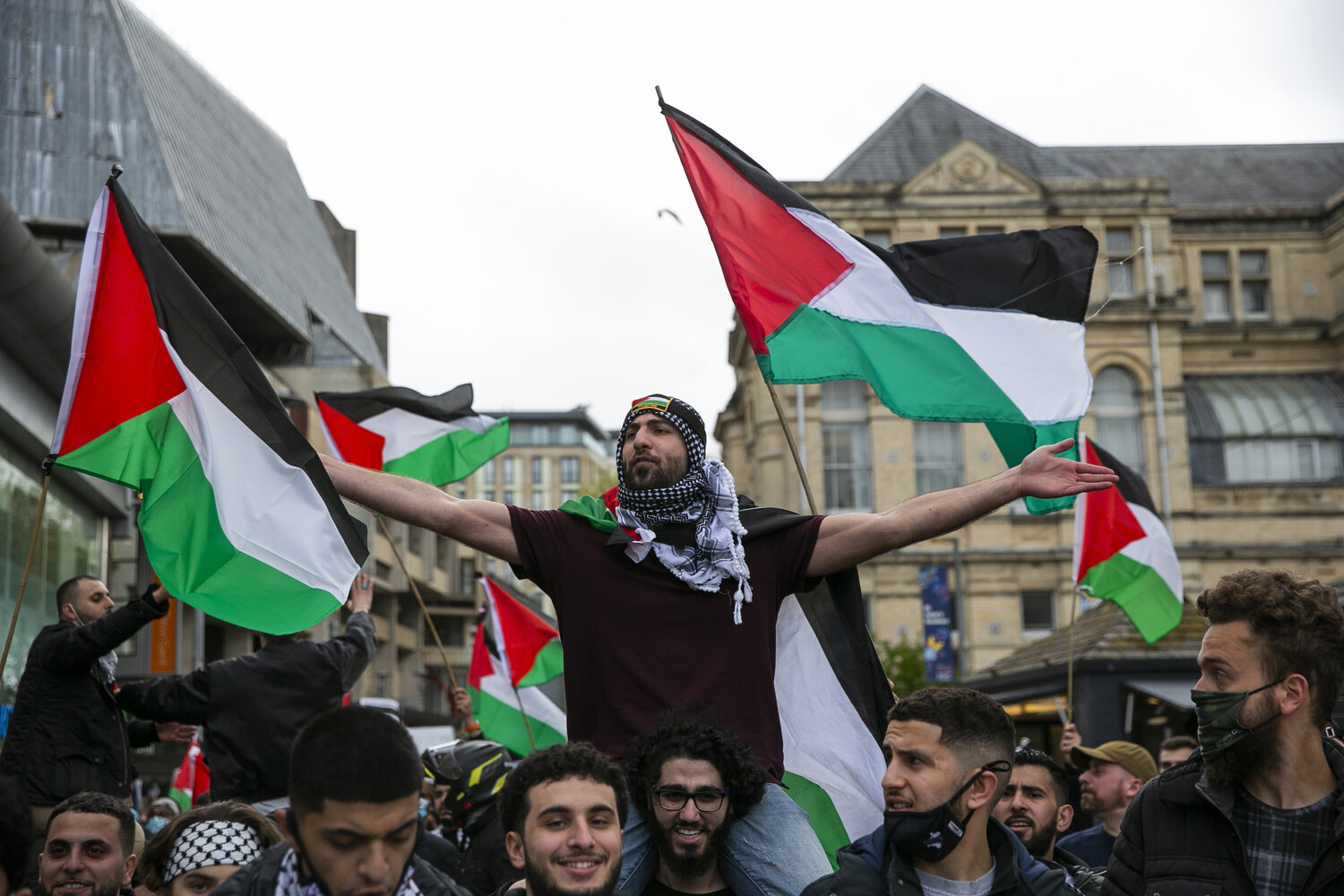
“Ι Wake Up and Get Angry All Over Again” – Cardiff Rings With Rage for George Floyd
YESTERDAY’S PROTEST OUTSIDE CARDIFF CASTLE ATTRACTED HUNDREDS WHO GATHERED TO CONDEMN STRUCTURAL RACISM IN BOTH THE U.S AND THE UK
IT FOLLOWS A WAVE OF DEMONSTRATIONS ACROSS THE U.S IN THE PAST WEEK AFTER A BLACK MAN, GEORGE FLOYD, WAS KILLED BY A WHITE COP KNEELING ON HIS NECK FOR MORE THAN EIGHT MINUTES
PROTESTERS IN CARDIFF HELD BANNERS READING “I CAN’T BREATHE”, “SAY THEIR NAMES” AND “BLACK LIVES MATTER”
F CLARKE, AT THE PROTEST YESTERDAY, SPOKE TO PEOPLE THERE.
By F Clarke. Protesters in front of Cardiff castle raise their fists. Picture, Angharad Arnold.
Protesters gathered in Cardiff city centre yesterday to show solidarity with the Black Lives Matter movement and US protesters, and push to the fore the issue of structural racism in Britain. As crowds gathered in the swelling heat – all the while trying to keep a distance from one another – chants of ‘No Justice, No Peace!’ rang out through the city centre.
“It was truly incredible, I felt really empowered to be a part of it” said organiser Seun Seriki speaking to voice.wales afterwards. The Cardiff action was part of a wave of international solidarity with Black Lives Matter movement in America.
Demonstrations have swept across the US after the death of George Floyd, the 46-year-old unarmed black man who was murdered by a white police officer in Minneapolis, Minnesota, a week ago. Marchers have faced down heavily armed police, the National Guard and have even reached the White House in what has become a totemic struggle against racism in America.
Protests and marches also took place in London and Manchester yesterday.
Last Monday, Derek Chauvin, 44, was filmed kneeling on George Floyd’s neck for more than eight minutes, while George Floyd is recorded repeatedly saying that he is unable to breathe.
George Floyd’s death has become a symbol of police brutality in the US, and of structural oppression elsewhere.
Last year, academics found that 1 in 1,000black men and boys in America can expect to die in encounters with the police – making them 2.5 times more likely to die at the hands of police than their white counterparts.
As the study lead Frank Edwards told the LA Times, “That’s better odds of being killed by police than you have of winning a lot off scratch-off lottery games.”
Displays of such violence and racism are not limited to the authorities. The death of George Floyd comes just months after another black man, Ahmaud Arbery, was shot – by a white father and son – while out jogging in a south Georgia neighbourhood.




Outside Cardiff Castle on Sunday afternoon, masked protesters – while trying to maintain social distancing – gathered in their hundreds in the afternoon heat, many coming forward to take to the megaphone and share their own experiences of racism, while others offered words of solidarity and allyship. Mirroring the street movement which has rocked America, this was a multiracial demonstration of unity, led by people of colour.
Several speakers mentioned the name of Christopher Kapessa – the 13 year old boy who drowned in the River Cynon last July while out with a group of friends. Earlier this year Christopher’s mother, Alina Joseph, labelled the police and Crown Prosecution Service (CPS) institutionally racist, saying: “If this had been 14 black youths and a white victim we have no doubt that the approach of the police and outcome would have been different.”
She was speaking after the CPS found that Christopher – who could not swim – had entered the river Cynon near Fernhill, South Wales, as a result of a deliberate push in the back by at least one of the boys present at the scene of his death, yet the CPS ruled that it was not in the public interest for them to prosecute any suspects.
Over the past week, mass demonstrations have taken place in at least 30 cities across the US, with curfews also implemented in many of these, including Los Angeles, Chicago, Atlanta and Philadelphia.
For organisers in Cardiff, the situation inspired action here, but also highlighted a need to acknowledge that this isn’t an issue limited to the US.
“For me this isn’t something new, this has been going on for a long time,” says co-organiser Seun Seriki.
“It’s a weird cycle where something horrible happens in the US and all of a sudden people in the UK are quick to jump up and say ‘we’re not as bad as them’…The truth is we are.”
“Solidarity is important because we need to address it together as one, and if people don’t come together then the cycle will just continue, not just in the US but in the UK as well. Which is why I couldn’t just sit back and not do anything.”
The protest attracted 2-300 people, Seun estimates, despite the event only appearing on Facebook several days ago.




One of the attendees was Sin, 21. This is the first protest she’s attended, but she’s encountered racism – implicit and explicit – almost daily throughout her life.
As the protest comes to an end and people trail away from Cardiff Castle, I ask her how she’s feeling.
“It just hurts and it just keeps hurting. I still get really emotional about it. I wake up and I get angry all over again. I cry and then I feel numb, and then I go through the cycle of grief, constantly.”
“Like they [the protesters] say, it’s the small things…the microaggressions… feeling like you’re the only black person in a room…we are made aware of our skin constantly. We can’t run away from it. Other people are lucky. Things like this can happen and they can look away and they can turn it off. Every time I look at myself in the mirror and look at my hands, I’m reminded that I am [black]. In a world that doesn’t treat us like we’re humans.”
For Sin, the fear of police brutality is a very real one, but she explains this isn’t just fear for her own safety:
“I worry about people that I know, but I worry more about people that I don’t know,” she explains.
“I’m lucky, I have privilege in that I am a light skinned black person, I might not be profiled in the same way as someone who looks more African American. So I worry about people who look threatening…we’re not criminals.”
It’s at this point that Sin breaks down in tears.
She’s never met George Floyd, yet his death feels personal – and this is a sentiment that seems to resonate with many individuals at the demonstration, many of them holding banners with “I can’t breathe” written on them – some of the last words uttered by George Floyd as he pleaded with Derek Chauvin.
“I can’t even say that phrase anymore…I’m going to remember him all the time,” she admits.
Reflecting on the protests across the US – many depicted as aggressive and violent by the mainstream media – Sin says the anger is justified.
“One thing I want to say is that it’s not fair to tell people how black people should react. Because it’s from slavery to segregation, to 400 years or more of just anger and generational trauma and people carry it with them all the time – you see it in their eyes.”
“When you see anger in the streets, if it’s from black people it’s justified because…when the world doesn’t treat you like you deserve to be treated, black people – we’re gonna get tired…you react, you get angry.”
As people around the world take to social media to vent their anger at structural racism and oppression, many people of colour are posting about the need for white people to acknowledge their privilege, and to call out racist behaviour.
“So for white people especially – and this isn’t me trying to single out – but to be an ally, you have to do it without expecting praise,” says Sin.
“You have to also be able to step back and let people speak and let people feel what they’re feeling and not make it a personal thing. You have to have these really uncomfortable conversations with people in your family and your friends, your colleagues…”
For Sin, George Floyd must be remembered when the protests die down, when the media goes away, when his name is no longer trending on social media.
“I want him to be remembered… I don’t want to turn a blind eye,” she says desperately.
“These people have to be remembered for more than just their deaths. They have to be remembered for the lives they’ve lived. George Floyd was a great man. He was the kind of person that had so much love for the world and a lot of these people, it’s the same thing. It’s just unfair and unjust. And I really, really just hope that this is the thing that changes it all.”
Images inset by FClarke and Angharad Arnold


